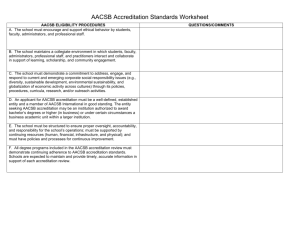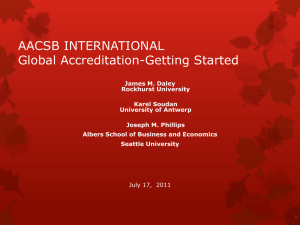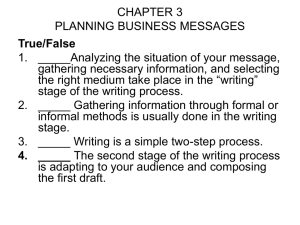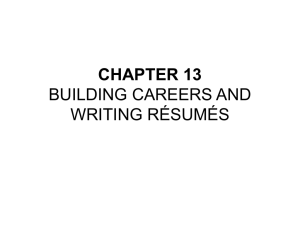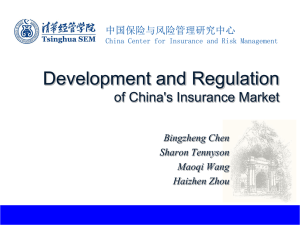AACSB Update, by Robert Reid - Southern Business Administration
advertisement
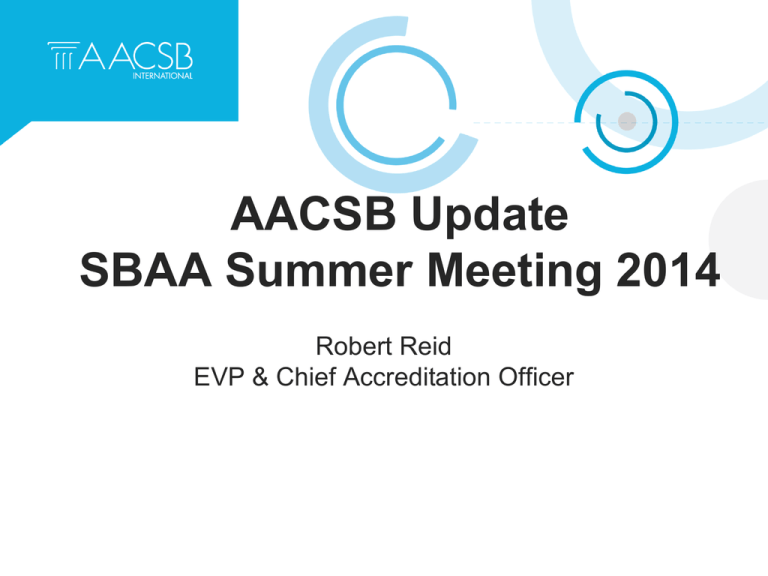
AACSB Update SBAA Summer Meeting 2014 Robert Reid EVP & Chief Accreditation Officer Topics • Membership and accreditation – – – – – Profile Accreditation pillars Training and seminars What we've learned Accreditation Management System (AMS) • AACSB 2020 committee • Amsterdam office • CEO search Reach of AACSB International AACSB-accredited members present AACSB members present No AACSB members present Distribution of schools as of June 2, 2014. The AACSB Network • 1,369 member business schools in 89 countries and territories • 711 accredited schools in 47 countries and territories (less than 5% of the estimated number of schools offering business degrees worldwide) • 180 accounting-accredited programs in 7 countries and territories • 50 corporate/foundation/non-profit members The World of Management Education Estimated Schools Offering Business Programs AACSB Members AACSBAccredited In Accreditation Process Africa 19 3 3 846 Eastern, South-Eastern, and Southern Asia 233 52 70 7,896 Central and Western Asia 64 12 13 606 Europe 240 80 53 2,467 Latin America and the Caribbean 79 18 10 2,147 Northern America 694 528 37 1,730 Oceania 40 18 7 98 1,369 711 193 15,790 Region Global Source: AACSB data and analysis as of 6/2/2014. Engagement - Innovation – Impact • Executive summary of most significant strategies and outcomes in the past five years related to engagement, innovation and impact • Review Accreditation Standards Appendix for suggested areas of potential Impact, p. 47-50 7 Engagement Schools are expected to: • Achieve both academic and professional engagement by students and faculty • Identify desired characteristics of engagement, aligned with the school’s mission • Maintain an appropriate balance of academic and professional engagement 8 Engagement Focus • Mission contextual and must focus on ensuring students, faculty and other stakeholders participant in the life of the business school • Linked to Eligibility Criterion B, Standards 1, 2, 5, 9, 10, 13, and 15 9 Engagement Possibilities • Strategic decisions about deployment of professionally engaged faculty (IP & PA) • Faculty & student engagement with business community • Faculty & student engagement with broader academic community 10 Innovation Schools are expected to: • Pursue continuous improvement • Be entrepreneurial and experiment • Innovate – Innovations include both the potential for success and risk of failure – Innovations should be well-developed and aligned with mission/strategy • Report most significant activities and results • Mission contextual innovation is the focus 11 Innovation Focus The mission of the business school is the context: • Innovation is focused on stakeholders and not unique from other business schools • Focus on most recent 5-year period • Linked to mission & strategic plan development and implementation (Standard 1) • The question is: “What is new for us?” 12 Innovation Possibilities • Adding on-line or distance delivered courses and/or degrees • New areas of programming • Distinctive service/outreach projects • Distinctive collaborative activities with business, non-profits, government, or other institutions • New student engagement activities • New research initiatives 13 Impact School’s are expected to: • Focus on outcomes that have impact • Produce intellectual contributions that have a positive impact on theory, teaching and practice • Demonstrate that the business school is “making a difference” in business and society 14 Types of Impact Standards Appendix • • • • • • • • Mission alignment impact Intellectual contributions impact Academic impact Teaching & instructional impact Academic program impact Practice & community impact Executive education impact Research center impact 15 Impact Focus Through mission execution, how is the business school making a difference? • Success/impact of graduates/students • Research outcomes • Community and business related outcomes • Can be localized to stakeholders • Linked to Standards 1, 2, 8, 9, and 15 16 Impact Possibilities • Translation of research outcomes into consulting, executive education/continuing education programming, practice oriented ICs • Participation in policy development • Success of graduates • Impact on professional practice • Impact on academic societies • Journal quality & citations • Successful educational materials 17 Accreditation – Transition • Seminars updated and offered globally – Business Accreditation and Accounting Accreditation Seminars • Volunteer training – 400+ volunteers trained in 17 workshops held in Asia, Europe, North America – Evaluations 3.9/4 point scale – Webinar for early Peer Review Teams – Additional training planned for 2014-15 2013 Accreditation Standards What we’ve learned from schools: – Positive feedback about PRT preparation – Accreditation staff resources receive positive feedback – Demonstrating engagement and impact is evolving – Suggestions for revision to PRT report and Fifth Year Report Guidelines 2013 Accreditation Standards What we’ve learned from Peer Review Teams: – Schools criteria and documentation for Std 15 Faculty Engagement and Qualification were well done – Engagement documentation is immature – Need to modify the PRT report to better align with the Fifth Year Report Accreditation Management System • Current accreditation process • Accreditation web based portal – Schools – Mentors – Peer Review Team members – Accreditation Committees • Timeline • Beta testing & rollout 2020 Committee Charge “Recommend strategies and structures to significantly increase AACSB’s achievement of its global mission, providing for superior membership advantage as well as quality improvement and quality assurance services, with particular focus on emerging economies.” 2020 Committee Methodology – Committee meetings and discussion – Emerging economies research – Outreach & engagement with business schools in emerging economies 2020 Committee Timetable – January 2014: Board of Directors launched the committee – September 2014: Interim report to AACSB board – Fall 2014: Global engagement and feedback – January 2015: Final report to AACSB board AACSB Office in Amsterdam • April 2014: Board of Directors approval • Service area – Europe, Middle East and Africa • Timeline • Recruiting – Senior Vice President – Initial staff AACSB CEO Search • Process – Search Committee – Search Firm – Input from members Sample Member Feedback Sessions Northeast Business Deans Association Annual Meeting Middle Atlantic Association of Colleges of Business Administration Annual Meeting September 13, 2013 October 22, 2013 Western Association of Collegiate Schools of Business Annual Meeting Council of Texas Deans Annual Meeting October 28, 2103 October 8, 2013 Middle American Business Deans Association Annual Meeting Southern Business Administration Association Annual Meeting November 12, 2013 October 14, 2013 AACSB Deans Conference Association of Jesuit Colleges and Universities Business Deans Conference February 2-4, 2014 October 13-15, 2013 AACSB Accounting Accreditation Seminar AACSB Europe Annual Conference October 19, 2013 AACSB Middle East and Africa Annual Conference October 21, 2013 February 8, 2014 CEO Search • Timetable • Feedback – To provide additional input regarding the CEO recruitment effort or to express interest as a candidate, please contact Kim M. Morrisson or Betty Hasler at AACSB_CEO@divsearch.com Questions and Discussion



